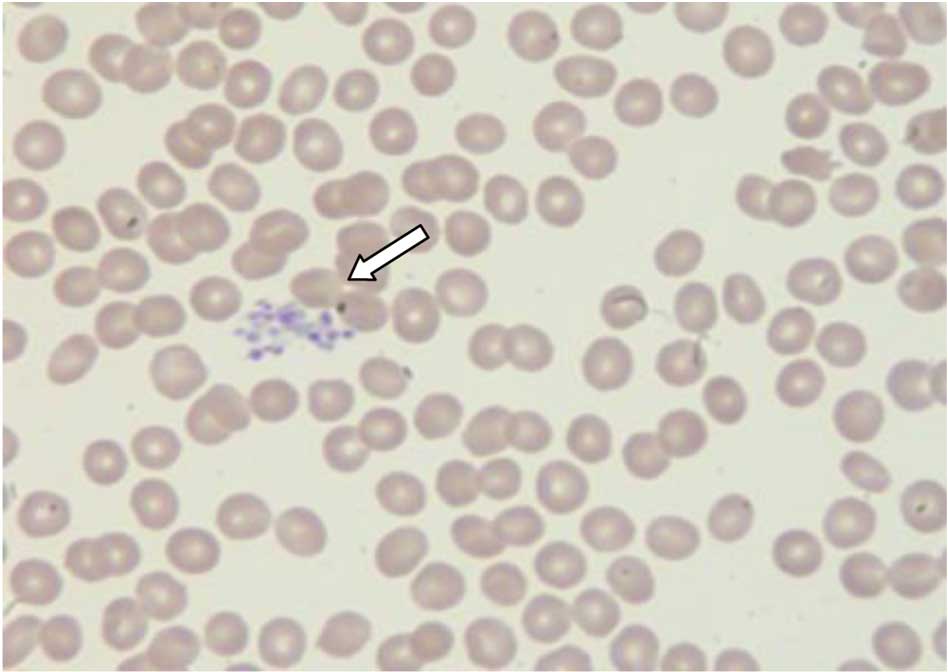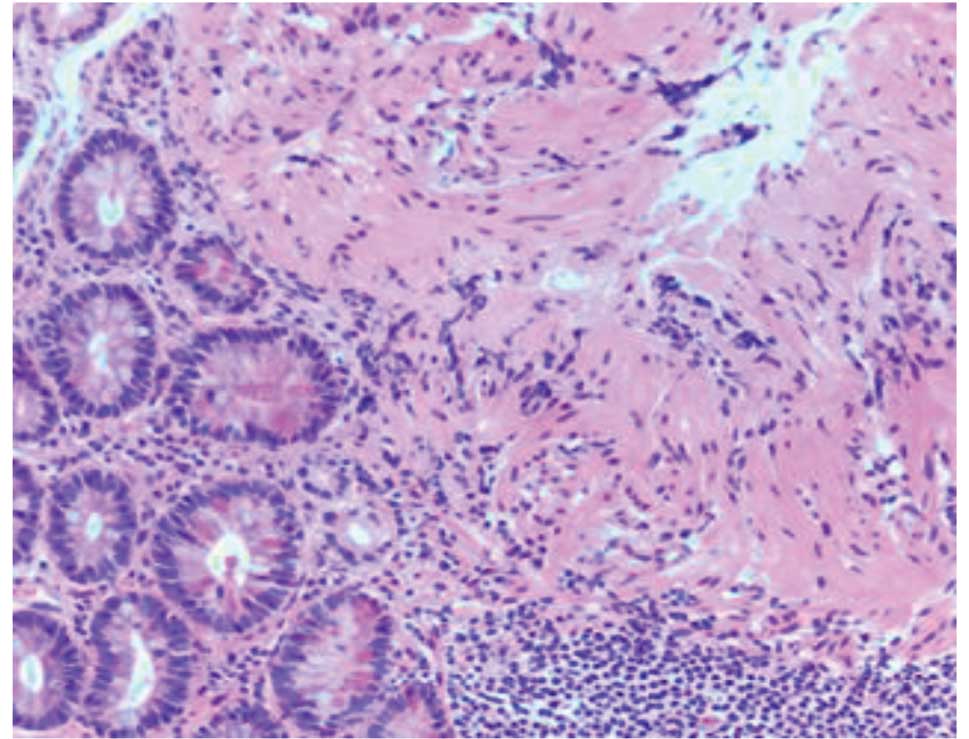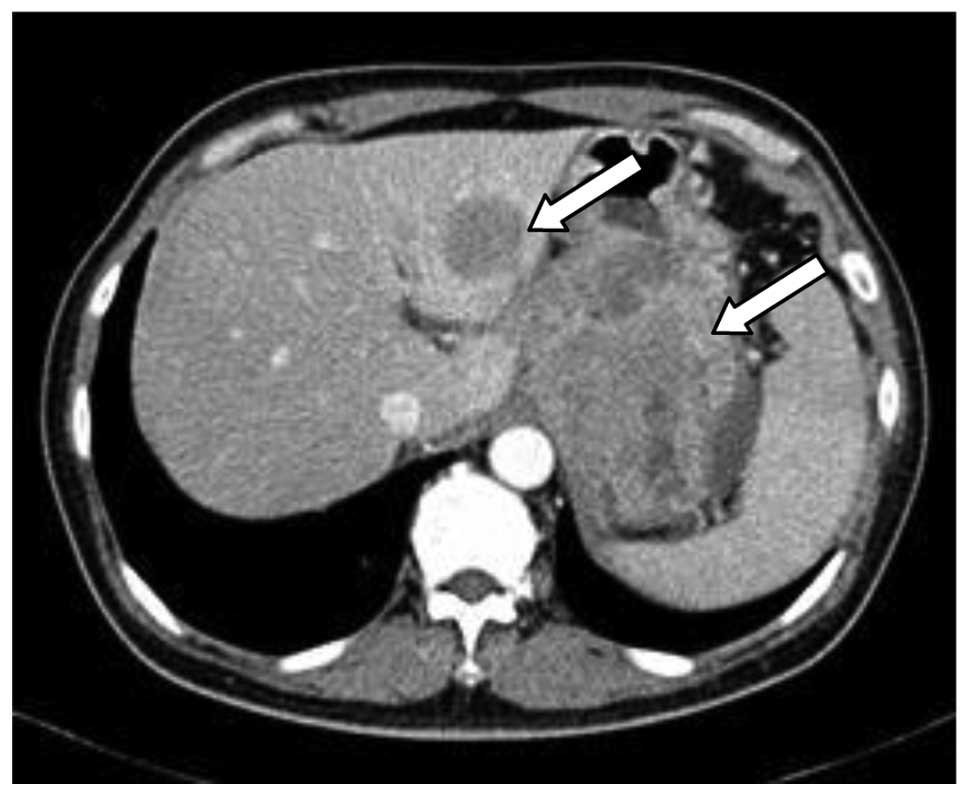Introduction
Ethylenediaminetetraacetic acid (EDTA) is commonly
used as an anticoagulant in sampling tubes for blood cell counts.
EDTA-dependent pseudothrombocytopenia (EDTA-PTCP) is an in
vitro phenomenon consisting of EDTA-induced platelet
aggregation at room temperature (1). This phenomenon occurs due to
anti-platelet antibodies that cause platelet clumping in blood that
had been anticoagulated with EDTA. EDTA-PTCP may be recognized by
the presence of platelet clumps in the peripheral blood smear.
EDTA-PTCP has been observed in a general hospital,
with a prevalence of 0.1% (2,3). It
has been reported in patients with various diseases, including
sepsis, multiple myeloma, acute myocardial infarction and breast
cancer (4–7). Since unrecognized EDTA-PTCP may result
in inappropriate treatment, it should always be considered as a
possible cause of low platelet counts in patients.
This study reports a case of transient EDTA-PTCP
observed in a patient with neuroendocrine carcinoma of the stomach.
The case report was approved by the Institutional Review Board
(IRB). As it involved no risk to the patient, the waiver of
informed consent was allowed by the IRB.
Case report
A 50-year-old male presented with epigastric pain
lasting for one month and a weight loss of 15 kg. Physical
examination revealed epigastric tenderness. The patient had no
history of bleeding problems and there was no family history of
hemorrhagic disorders. The patient did not use alcohol or any
medication.
An initial complete blood count (CBC) using EDTA as
an anticoagulant revealed a low platelet count (19×103
platelets/μl). The biochemical tests were within the normal ranges.
The microscopic examination of the peripheral blood smear revealed
platelet clumping (Fig. 1). CBC
using sodium citrate as anticoagulant revealed a normal platelet
count (236×103 platelets/μl).
Gastroduodenoscopy revealed a large ulcerated mass
from the cardia to the fundus of the stomach (Fig. 2). Endoscopic biopsies of the mass
confirmed the diagnosis of small cell neuroendocrine carcinoma
(Fig. 3). Computed tomography (CT)
scans of the abdomen revealed an irregular mass with perigastric
infiltration in the stomach and a metastatic mass in the liver
(Fig. 4).
Systemic chemotherapy using etoposide and cisplatin
was performed. Following four cycles of chemotherapy, the follow-up
CT scan showed marked tumor regression (Fig. 5). Platelet clumping on the
peripheral blood smear disappeared and the platelet count in blood
anticoagulated with EDTA was also normalized.
Discussion
PTCP is of practical significance in consequent
clinical decisions or therapeutic interventions (6). In the evaluation of patients with
thrombocytopenia, a key first stage is to rule out PTCP,
particularly in patients without an apparent cause for
thrombocytopenia. PTCP is an in vitro artifact that results
in erroneous platelet counts. PTCP is caused by in vitro
platelet clumping which is induced by antibody-mediated
agglutination secondary to platelet activation resulting from
inadequate blood sampling or delayed introduction to an
anticoagulant in the test tube.
EDTA is commonly used as an anticoagulant for CBC.
EDTA-PTCP occurs due to anti-platelet autoantibodies that cause
platelet clumping in the presence of EDTA (4,8). These
antibodies, usually IgG but also IgM and IgA, recognize platelet
antigens on the platelet membrane modified by EDTA (1,9), which
results in platelet agglutination. Automatic analyzers interpret
platelet clumps as white blood cells (3). If thrombocytopenia is obtained in
EDTA-anticoagulated blood, microscopic evaluation of the peripheral
blood smear should be performed. In addition, the platelet count
should be determined in blood collected into sodium citrate or
heparin. In this case, the peripheral blood smear showed platelet
clumps and the platelet count was normalized in blood that was
anticoagulated by sodium citrate.
EDTA-PTCP has been identified in healthy subjects
and patients with various conditions, including gastrectomy,
autoimmune diseases, liver diseases, cardiovascular diseases and
viral infections (4,5,10–14).
EDTA-PTCP has also been reported in association with neoplastic
diseases, including breast cancer and multiple myeloma (6,7). It
has been suggested that damaged platelets in a variety of diseases
may expose cryptic antigens and induce the synthesis of
anti-platelet antibodies (4,15).
Platelet-associated autoantibodies against glycoprotein (GP)
Ia/IIa, Ib/IX or IIB/IIIA have been detected in these patients
(4,7). However, the clinical relevance of
EDTA-dependent anti-platelet autoantibodies remains uncertain.
To the best of our knowledge, this is the first case
of EDTA-PTCP occurring in a patient with neuroendocrine carcinoma.
In the current patient, EDTA-PTCP coincided with neuroendocrine
carcinoma and disappeared following chemotherapy with marked tumor
regression. The mechanism by which this occurred is not clear but
an association of EDTA-PTCP with neuroendocrine carcinoma is
suggested.
References
|
1
|
Pegels JG, Bruynes EC, Engelfriet CP and
von dem Borne AE: Pseudothrombocytopenia: an immunologic study on
platelet antibodies dependent on ethylene diamine tetra-acetate.
Blood. 59:157–161. 1982.PubMed/NCBI
|
|
2
|
Bartels PC, Schoorl M and Lombarts AJ:
Screening for EDTA-dependent deviations in platelet counts and
abnormalities in platelet distribution histograms in platelet
distribution histograms in pseudothrombocytopenia. Scand J Clin Lab
Invest. 57:629–636. 1997. View Article : Google Scholar : PubMed/NCBI
|
|
3
|
Savage RA: Pseudoleukocytosis due to
EDTA-induced platelet clumping. Am J Clin Pathol. 81:317–322.
1984.PubMed/NCBI
|
|
4
|
Mori M, Kudo H, Yoshitake S, et al:
Transient EDTA-dependent pseudothrombocytopenia in a patient with
sepsis. Intensive Care Med. 26:218–220. 2000. View Article : Google Scholar : PubMed/NCBI
|
|
5
|
Kocum TH, Katircibasi TM, Sezgin AT and
Atalay H: An unusual case of mismanagement in an acute myocardial
infarction: pseudothrombocytopenia. Am J Emerg Med. 26:740.e1–2.
2008. View Article : Google Scholar : PubMed/NCBI
|
|
6
|
Abe H, Shimizu T, Cho H, et al: Occult
breast cancer with EDTA-dependent pseudothrombocytopenia - a case
report. Gan To Kagaku Ryoho. 37:915–918. 2010.PubMed/NCBI
|
|
7
|
Reed BW and Go RS: Pseudothrombocytopenia
associated with multiple myeloma. Mayo Clin Proc. 81:8692006.
View Article : Google Scholar : PubMed/NCBI
|
|
8
|
Lombarts AJ, Zijlstra JJ, Peters RH, et
al: Accurate platelet counting in an insidious case of
pseudothrombocytopenia. Clinic Chem Lab Med. 37:1063–1066.
1999.PubMed/NCBI
|
|
9
|
Fiorin F, Steffan A, Pradella P, et al:
IgG platelet antibodies in EDTA-dependent pseudothrombocytopenia
bind to platelet membrane glycoprotein IIb. Am J Clin Pathol.
110:178–183. 1998.PubMed/NCBI
|
|
10
|
Berkman N, Michaeli Y, Or R and Eldor A:
EDTA-dependent pseudothrombocytopenia: a clinical study of 18
patients and a review of the literature. Am J Hematol. 36:195–201.
1991. View Article : Google Scholar : PubMed/NCBI
|
|
11
|
Tomonari A, Hirai K, Aoki H, et al: Pure
red cell aplasia and pseudothrombocytopenia associated with
hepatitis A. Rinsho Ketsueki. 32:147–151. 1991.(In Japanese).
|
|
12
|
Saburi Y, Aragaki M, Matsui S, et al: An
adult patient with EDTA-dependent pseudothrombocytopenia due to
rubella virus infection. Kansenshogaku Zasshi. 67:594–597. 1993.(In
Japanese).
|
|
13
|
Sawazaki A, Nakamura N, Jyokaji H, et al:
Guillain-Barré syndrome and ethylene diamine tetraacetic
acid-dependent pseudothrombocytopenia associated with mumps. Intern
Med. 35:996–999. 1996.
|
|
14
|
Wenzel F, Lasshofer R, Rox J, et al:
Transient appearance of postoperative EDTA-dependent
pseudothrombocytopenia in a patient after gastrectomy. Platelets.
22:72–74. 2011. View Article : Google Scholar : PubMed/NCBI
|
|
15
|
van der Lelie J, van der Plas-Van Dalen CM
and von dem Borne AE: Platelet autoantibodies in septicaemia. Br J
Haematol. 58:755–760. 1984.
|



















